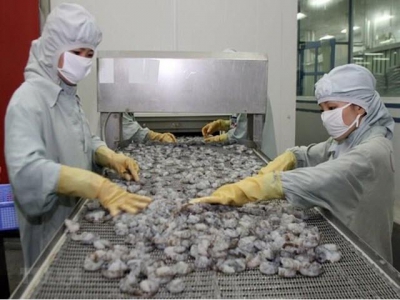Shrimp export falls 8.1 percent in eight months

Hanoi – Vietnam exported 1.93 billion USD worth of shrimp during January-August, down 8.1 percent from the same period last year, according to the Ministry of Agriculture and Rural Development’s Directorate of Fisheries.
Shrimps processed for export (Photo: VNA)
The pace of reduction in exports has slowed down due to positive export growth in July. Last month, shrimp export reached some 334 million USD, posting a year-on-year increase of 13.4 percent.
The country saw good growth in exports to eight major markets like the EU, Japan, the US, mainland China, the Republic of Korea, Canada, Australia and China’s Taiwan.
The Vietnam Association of Seafood Exporters and Producers (VASEP) expected shrimp exports to grow further this year to a value of more than 4 billion USD thanks to robust signs in the market.
According to the association, the shrimp sector will make breakthroughs in exporting to 28 European Union countries, with estimated export value of 1 billion USD, as it will enjoy low import tariffs once the EU-Vietnam Free Trade Agreement takes effect.
Another positive sign comes from the US market. Most recently, The US Department of Commerce (DOC) released the final results of the 13th period of review (POR 13), officially imposing zero percent tariffs on 31 Vietnamese shrimp exporters.
VASEP General Secretary Truong Dinh Hoe said the preliminary tariff would encourage local firms to promote shrimp shipments to the US in the coming months because they had faced many challenges in exporting this kind of seafood to the American market, including anti-dumping tariffs.
A lower tariff will help Vietnamese shrimp compete better with other foreign rivals, he said.
Giving his comments on shrimp shipments in the coming months, Hoe stressed demands for shrimp normally increase in the end of the year, particularly, orders from the US have increased while the nation is reducing purchase from India, Thailand and China.
Furthermore, India’s shrimp harvest season has ended, giving room for global shrimp to surge.
The Directorate of Fisheries suggested local producers work to ensure product traceability and quality, while VASEP said that it is necessary to promote exports of high-added value products to avoid anti-dumping tariffs in foreign countries.
Có thể bạn quan tâm
 Pangasius industry tasted 'bitter fruit' because of overheat
Pangasius industry tasted 'bitter fruit' because of overheat Recently, pangasius farming area recorded a mass increase, causing a rapid increase in production. Along with that, the main export markets of pangasius
 Coding and locating each pangasius farm
Coding and locating each pangasius farm The direct export of pangasius to the Chinese market is facing new challenges with traceability and identification codes being included.
 Quảng Ninh approves $36m hi-tech farming zone
Quảng Ninh approves $36m hi-tech farming zone Farming zones applying technological advances dedicated to coffee trees are mostly in the Central Highlands, northwest and north central regions.